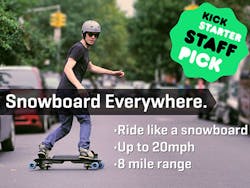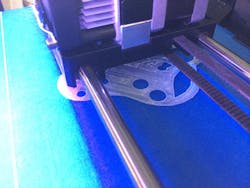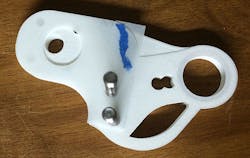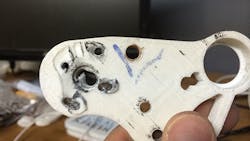The biggest manufacturers in the world spend millions of dollars and thousands of man hours to innovate and develop the products of the future as quickly and cheaply as possible. However, with mass customization, crowdsourcing, the rise of crowdfunding sites and the continual blurring of lines between consumers and entrepreneurs/part-time professionals, many times it seems the big-budget R&D teams often have to play catchup with a new breed of tech-enabled innovators/entrepreneurs, working in their spare times and spare rooms, and pushing the frontier further in even formerly stable markets.
I'm lucky enough to live in a city filled with these kinds of passion projects and have used this blog in the past to highlight certain areas of this evolving process, bringing successes and challenges to all the enterprise R&D/product development professionals in IndustryWeek's core audience. What follows is an example how two snowboarding-obsessed young guys -- one a serial entrepreneur and the other a recently-graduated engineer -- came together to develop the world's first motorized eSnowboard that brings the experience of snowboarding to city streets and how they went from concept to prototype to "market launch" (in only six months!) by employing a modified prototyping/iteration process using 3D printers as a key tool in the process.
Inventing a New Way to Snowboard
Many people all over the world thrill with the exhilaration of snowboarding (including you, or perhaps more likely, your kids/nieces/nephews), but there's a catch -- you need a mountain, lots of snow and likely a chairlift to make it an "easy" experience to achieve. Given those caveats, you've already cut out the vast majority of the world's population, as well as most seasons of the year.
Rather than developing a better snowboard, two guys in New York City thought, "Why not develop a snowboard that anyone can use all year round so that you don't need snow? Better yet -- why not cut out the mountain too and snowboard across a flat surface?" Thats exactly what Aaron Aders and Daniel Seagren set out to do with their new company LEIFTech.
Building the Team with a Dream
“I don't just want to snowboard everywhere, I need to snowboard everywhere” said Aders in explaining his passion and motivation for the LEIF project, “I had the dream and theoretical design, but I didn't have the expertise to see this invention come to life. I needed a top-notch engineer who shared my passion for snowboarding.”
Armed with an entrepreneur's wit and a sign that simply read 'Entrepreneur looking to partner with Mechanical Engineer -- MUST be obsessed with snowboarding', Aders pasted the halls of Columbia University's engineering school looking for the perfect fit. In the age of social networking and digital connection tools, this handwritten sign was the vector for finding Daniel Seagren, a California-raised Mechanical Engineering student, who (serendipitously enough) was wrapping up his final semester and beginning his job search. Few companies would call a young entrepreneur with a full-time job and an engineering school senior a "dream team", but this was a team with a dream -- and as we all know, big dreams are often much more valuable than big budgets.
Inventing the Impossible
For background, Aders and Seagren called many industry experts and companies that specialized in developing the various components, many of whom told them that many of the technical details were either crazy or impossible to develop. "Engineering to me has always been about challenging and rewriting the status quo," notes Seagren. "So when I heard people say that this [project] was impossible, it just fueled my desire to keep pushing the limits of what was possible to achieve the previously unachievable" recalls Seagren on inventing new solutions on the fly.
“Luckily we were also able to draw on expertise from MIT engineers and TED fellows in our building that dreamed big and were working on even crazier projects. To them, solving new and complicated problems went with their daily coffee” says Aders. The team credits local experts like Bill Washabaugh of Hypersonic, James Patten of Patten Studios and others in the eclectic workspace Metropolitan Exchange (Mex) in helping them solve impossible problems.
Innovating Product Iteration Using 3D Printing
The team used multiple 3D printers during product development and component iteration. For instance, a borrowed MakerBot Rep2 desktop printer allowed fast iteration of designs and perfection of components to occur in minutes, rather than the typical turnaround of days or weeks with most rapid prototyping services and room-size machines. “We couldn't have completed this project on such a tight budget and timetable without desktop 3D printing. If your design was a few millimeters off, then you just throw it away and print another updated copy in minutes” recalls Aders.
Seagren and Aders also optimized their design process to iterate in record time. They discovered that it was faster and easier to perfect certain aspects of a part rather than working on the part as a whole. Recalling their optimized iteration process, Aders adds “For example, with the motor mounts we discovered that printing only the profile of a piece was faster and easier when testing a specific fit or functionality. We reduced iteration time from hours to literally minutes. This brought the whole design together much faster than printing out the entire piece every time.”
Achieving the Dream
By hewing to this modified iteration process, the team was able to perfect specific parts before making big investments in machined metal parts. “The 3D printed parts got us a long way. We could ride the prototype board about two blocks before the plastic melted, but that was enough to let us know if our design worked or failed” recalls Aders.
This process paid off and resulted in a perfect fit on the first run of the final machined aluminum components. On the time and cost savings, Aders adds “The machined metal parts were exactly 636 times the cost of the 3D printed version, so we were very happy to get it right the first time”.
If you or anyone you know is up for a good carve on a city street, you can learn more about the LEIF eSnowboard and view a video of their story and the product on the LEIF Kickstarter page.







